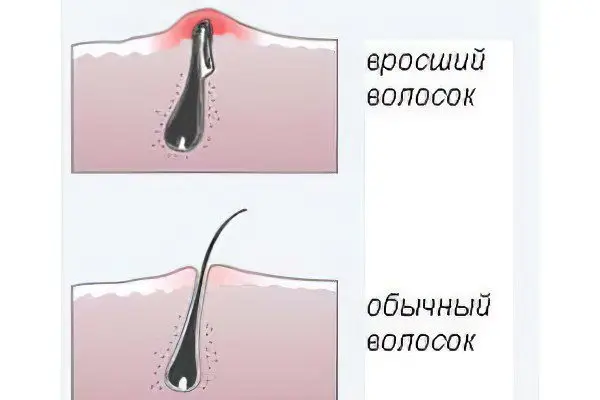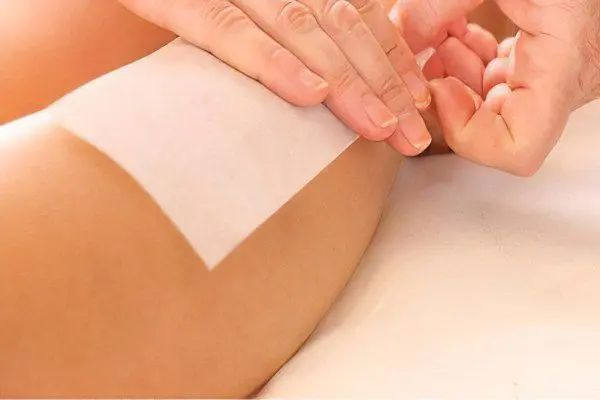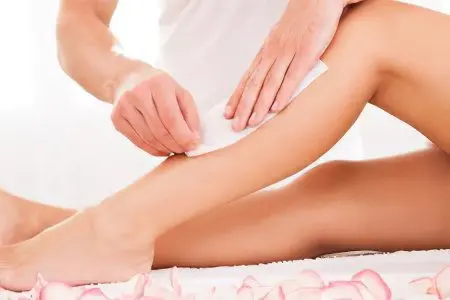Contents

Pseudofolliculitis is a disease characterized by a violation of hair growth on various parts of the body. The hair shaft in this case does not come out from under the skin, but remains inside it and begins to sprout.
Most often, pseudofolliculitis develops in those places where a person seeks to get rid of unwanted hair and regularly removes them. Several areas are most susceptible to the disease: pubic and axillary, cervical and facial, as well as the skin of the lower extremities. When the hair begins to grow inward, a small swelling forms on the skin of a person, which turns red and itches.
If a woman in the bikini area has a bump on the skin, then this may indicate an ingrown hair. Inflammation has a different degree of intensity. Sometimes you can find purulent contents that are visible under the skin, and sometimes it is invisible, however, this does not mean that the inflammatory process is absent. The response of the body will be launched in any case, since the hair growing deep into the skin is a foreign body that must be disposed of.
Risk group
It is worth noting that not all people are faced with pseudofolliculitis, although almost every man shaves his face, and a woman uses various methods of hair removal.
As a result of trauma to the skin, ingrown hairs will be observed more often in those at risk. First of all, this applies to people belonging to the Negroid race, and those who have hard and curly hair. Dry skin also increases the risk of ingrown hairs.
Another category of people prone to this disease are those whose angle of inclination of the follicle is too sharp in relation to the skin. This fact also contributes to the development of pseudofolliculitis.
Causes of Ingrown Hair
Depilation without preparation. Shaving without prior preparation will be a stress factor for the skin. If the skin has not been softened and moisturized in advance with the help of special products, then this may well lead to subsequent ingrown hairs. In addition, irritated skin after the depilation procedure must be soothed. For this, there are also special care products.
Depilation at home. The fight against unwanted hair with a razor (razor or electric equivalent), a special cream or wax-based strips is not reliable. These methods allow you to remove only the visible part of the hair that protrudes above the surface of the skin. At the same time, the bulbs themselves remain in the same place, that is, inside. The more often the hair is shaved, the thinner it becomes. The skin, on the contrary, due to microtraumas coarsens and becomes thicker. The epidermis becomes keratinized and becomes unable to exfoliate. In this case, the follicular mouths are closed. A weakened and thinned hair cannot break through the existing barrier and, as it grows, begins to twist in the form of a spiral. At the same time, the direction of its growth changes. Therefore, hair that grows in, even after depilation, becomes noticeable after two days. If such a problem occurs regularly, then superficial hair removal with hot wax or a razor should be abandoned. It is possible that a different method of depilation is more suitable for a woman, for example, using sugar paste (sugaring).
Hyperkeratosis. Sometimes people have too rapid keratinization of the epithelium, as a result of which it thickens and coarsens, which leads to difficulties during the germination of the hair out.
Failure to follow the technique of shaving hair. If you use a dull blade or shave against the direction of the hair growth, and shave your hair very carefully, all this can lead to ingrown hairs. The risk is also increased by applying too much pressure and pulling on the skin during shaving and if shaving is performed frequently.
Wearing tight or tight clothing, provoking irritation of shaved skin.
Signs of pseudofolliculitis

Signs of ingrown hairs include:
Hyperemia – after the depilation procedure, the skin swells and turns red. This symptom appears even before the ingrowth has occurred;
After 2 or 3 days after shaving or depilation, local pain occurs, the skin begins to itch. The place of ingrowth is compacted, a papule is formed;
If suppuration occurs, the contents of the papule may appear through the skin. It looks like a yellowish bump;
Sometimes a hair is visible through the upper layers of the epidermis, or rather, its tip or loop;
Milia are another symptom of an ingrown hair. They form a week or two after the hair shaft grows into the skin. Milia look like whitish nodules, dense to the touch;
If the process of ingrowth is complicated, then abscesses and abscesses may occur. Most often, infection is provoked by staphylococci and Pseudomonas aeruginosa.
Symptoms of the further development of the disease depend on the characteristics of the course of the pathological process:
The hair shaft can break through on its own. In this case, the inflammation gradually self-destructs;
An attempt to self-open an existing node with improvised means (tweezers, needle, nails) can lead to infection. In this case, a purulent pustule is formed, after a while a keloid scar will appear in its place, the damaged area will remain pigmented for a long time;
If you fix the problem in a medical institution or in a beauty salon, then a small wound will remain in place of the ingrown hair. After a short time, it will heal, hyperpigmentation in this case passes quickly.
When detecting the characteristic symptoms of pseudofolliculitis, it is important not to confuse this disease with other skin pathologies.
Similar symptoms are manifested by the following diseases:
Pyoderma;
Acne vulgaris;
folliculitis;
Follicular hyperkeratosis;
Ostiofolliculitis.
How to remove an ingrown hair in a medical facility?
When a seal forms on the site of an ingrown hair in a person, inside which purulent masses collect, this requires an appeal to a doctor. In addition, you should not postpone going to a dermatologist if there is a threat of further spread of the inflammatory process, as well as suppuration as a result of an independent attempt to remove an ingrown hair.
The doctor will do the following:
Open the abscess with sterile instruments (needle or scalpel);
Removes existing hair and pus;
Will perform antiseptic measures, most often hydrogen peroxide or Chlorhexidine is used for this;
Apply an antibacterial ointment and cover the treated area with a sterile dressing.
Medical manipulations are quite simple. However, when conducting them on their own at home, people often forget about observing the conditions of sterility at each stage of the procedure. As a result, an infection is often introduced under the skin. You should not independently open the existing pustules with pus on the face or neck. This is because due to the abundance of blood vessels in these areas, the infection can spread much faster.
Self removal of ingrown hairs

If the inflammation is at the aseptic stage, that is, there are no purulent masses, then you can try to remove the ingrown hair yourself. However, the methods listed below are not suitable for getting rid of pseudofolliculitis in the neck and face.
Non-invasive therapy
An ointment with antibacterial properties should be applied to the site of inflammation. This will make it possible to remove redness and eliminate puffiness.
After a day or two, the skin must be steamed and the dead epidermis removed. This is done using a scrub:
To prepare a salt exfoliating composition yourself, you will need a pound of salt, vegetable oil (200 ml) and turmeric (1 pack);
Salt scrubs in finished form are sold in pharmacies;
To prepare a coffee scrub, you need about 100 g of sugar, 2 cups of ground coffee and vegetable oil (3 teaspoons), all components are mixed and used for their intended purpose.
After treatment, the skin is washed, the hair should come out either immediately or after 24 hours. If necessary, manipulations can be repeated.
Sometimes you can help the hair break through with the help of a badyagi-based composition. To do this, you need to take one part of this drug, mix with 2 parts of Chlorhexidine or hydrogen peroxide and leave for 5 minutes on the problem area. However, this method does not help everyone, as badyaga accelerates hair growth.
If the inflammation has already begun, then a preparation based on salicylic acid or Skinoren gel, used to treat acne, can be applied to the problem area.
Invasive hair release
Doctors recommend refraining from opening an inflamed nodule in which there is pus. If, nevertheless, a decision was made on the invasive release of the hair, then it is better to wait until the moment when the purulent contents begin to protrude from under the skin, or at least shine through it.
Before proceeding with the procedure, the hands and the problem area are disinfected with alcohol. Then the hair is pulled with a sterile needle taken from the package with a new syringe. If necessary, use tweezers. After performing the manipulations, the skin is again treated with alcohol and a bandage with an antibacterial ointment is applied. The area affected by inflammation should be left alone and not epilated.
Prevention of pseudofolliculitis – how to deal with ingrown hairs?

For prevention, you can do the following:
Change the way of depilation. When the problem occurs due to shaving, you can use an electric epilator, hair removal cream or wax strips;
Stop shaving for a while. This advice is suitable for men, especially since wearing a beard is now a fashionable trend;
Follow the rules for shaving and waxing. If the hair is removed with a razor, then the movements should be directed in the direction of their growth. Do not repeatedly carry out the machine in the same place. The skin must not be stretched. If a specialized device is used to remove hair, then all actions should be performed according to the attached instructions;
Prepare skin for hair removal. The process consists of pre-treatment and post-treatment. Before starting the procedure, the skin should be steamed and freed from dead epithelial cells. Massage will help straighten your hair. It is important to use shaving foam or gel. After the procedure, the skin is treated with an antiseptic, and then with a cream that has a softening and disinfecting effect;
Do not remove or shave hair when it has not grown at least 2 mm;
Apply specialized products to slow down the rate of hair growth. For example, Planta, Dr. Bio, Aloe Vera cream and others;
Use anti-ingrowth medications. However, despite the high price, the effect of them is questioned;
Do not abuse scrubs. Do not scrub too often to exfoliate the skin. After the hair removal procedure for the first time, it can be applied after at least 3 days. Scrubs are contraindicated for use by those people who have severe skin peeling;
Take care of the skin of the face and body. The skin is subject to mandatory hydration after depilation, shaving and exfoliation. These manipulations dry out the skin, which means that they can provoke ingrown hairs.
If the ingrown hair has been removed, and a pigmented area has appeared on this site, you can use badyaga, ichthyol or salicylic ointment, as well as cream after depilation. This will speed up skin lightening.
Professional removal of unwanted hair
The choice of a way to get rid of the problem is carried out by a dermatologist individually in each case. Bioepilation can be used to prevent ingrown hairs, for example with wax or sugar. However, the effect of such procedures is temporary, and it is not always possible to achieve the desired result.
You can permanently eliminate hair growth with the help of laser and photoepilation. Both of these methods are non-contact and do not injure the skin. However, there are some contraindications to their use, for example, childbearing and breastfeeding, hypersensitivity to these methods, oncology, skin diseases.
Destruction using photoepilation is based on conducting light energy through the hair to its growth zone;
The destruction of the follicle with a laser or electric current is based on a point effect.
If you find a problem with ingrown hairs, you should not self-medicate, which is especially dangerous without following the rules for sanitizing the skin.
Author of the article: Herman Olga Leonidovna, trichologist, specially for the site ayzdorov.ru









